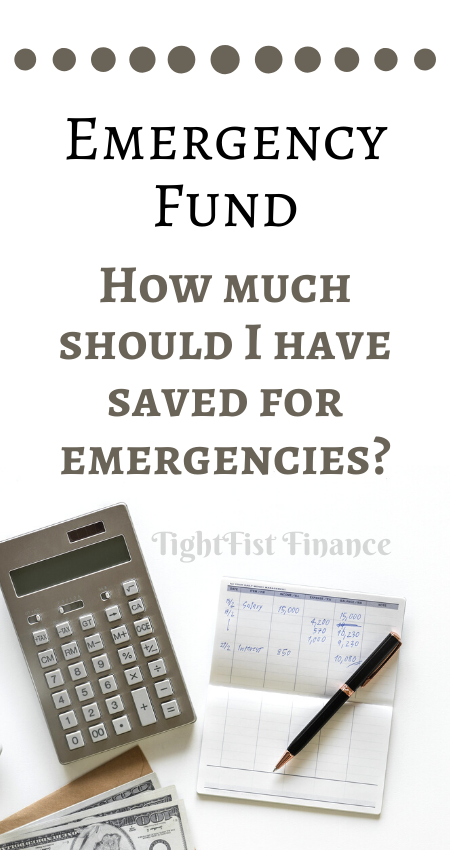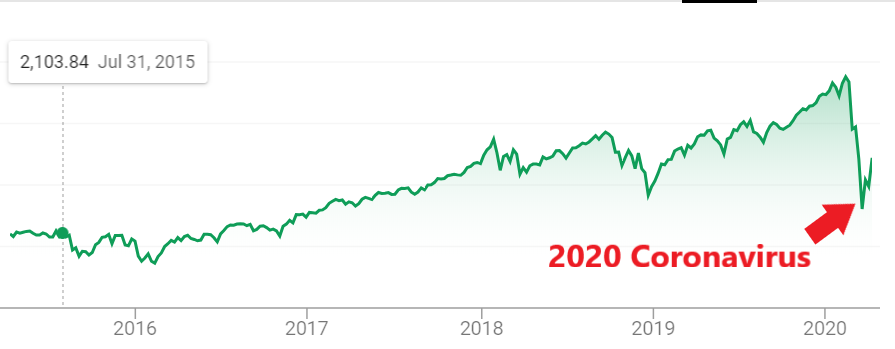Is your emergency fund amount sufficient to survive your next family emergency? How much money should you have saved for emergencies?
Life just happens.
One day, everything is great. The next day, your car breaks down or you suffer a job loss that significantly impacts your finances.
If you live paycheck to paycheck, having an emergency can be overwhelming. Having an emergency fund can greatly reduce your stress during troubling times.
Luckily for you, I’m going to show you how much money you should have saved for emergencies. Hopefully, this guide will help you build your emergency fund and protect your family from your next crisis.

This article may contain affiliate links which pays a commission and supports this blog. Thank you for your support!
How much money should you have in an emergency fund?
Generally, an emergency fund amount should be three to six months expenses. However, emergency fund amounts are only guidelines. You should evaluate your own financial situation and risk tolerance and save accordingly.
Start by saving $1,000
Immediately saving three to six months expenses can seem impossible for some families. Having debt can make saving for emergencies even harder, because your money is going towards debt, not savings.
As part of Dave Ramsey’s baby steps, Dave recommends everyone’s first step is to save $1,000 specifically for emergencies. After saving $1,000, focus on paying off your debt and then save three to six months expenses.
However, is saving $1,000 enough for most emergencies? The most costly emergency expenses are auto repair, home repair, and surprised medical expenses.
According to Cars.com and AAA, the average auto repair cost is between $500 and $600.
$1,000 is enough to cover minor home repair expenses. Examples include, replacing a hot water heater, AC refrigerant refill, and minor contractor costs. However, larger expenses like a roof replacement would not be covered.
An ER visit would cost approximately $50 to $150 copay for someone with insurance. Without insurance, expect to pay between $150 and $3,000 depending on the type of emergency. Ambulance fees can be an additional $1,000 or more.
As a rule of thumb, $1,000 is enough to cover most minor emergencies. However, $1,000 may not be enough depending on the emergency.
Click to Tweet! Please Share!Click To TweetPay off debt then save 3-6 months expenses
Now that you’ve paid off your debt, it’s time to get serious about building your emergency fund. The most severe and likely emergency would be loss of income. You need enough money to support your lifestyle for the three to six months it takes you to find a job.
Starting a budget is the best way to estimate your monthly expenses. How much money are you paying in rent/mortgage, bills/utilities, automatic payments, groceries, etc?
Multiply that number by the number of months you need to survive and that’s the number you should shoot for. Contribute whatever amount you can until your goal is achieved.
For example, maybe you pay a monthly $1,200 in rent, $480 in bills, $400 for groceries, $300 for gas. Overall, you pay nearly $2,400 in monthly expenses. For a six month emergency fund, you should target to save $14,400.
Don’t guess your expenses. Take the time to sit down and evaluate your monthly cash flow.
The factors that determine how much money you should put in an emergency fund
When building your emergency fund, Consider the following monthly expenses:
- Housing
- Transportation
- Food
- Medical and Prescription costs
- Debt payments
- Personal Expenses
- Utilities
You can also include unnecessary expenses that would allow you to have more fun during an emergency. Examples include vacations, dining out, shopping, etc. You may also want to save more if your chances are higher for a layoff or you have inconsistent income.
Click to Tweet! Please Share!Click To TweetWhere should I put my emergency fund?
Your emergency fund amount should be parked somewhere safe, where you won’t spend it and it won’t lose money. I recommend opening up a money market account for your emergency fund.
A money market account will earn more interest than a savings account. Your money will be readily available in case of emergency and your cash doesn’t lose value. High-yield savings account or certificate of deposits are other places you can store an emergency fund.
Should you invest your emergency fund in stocks?
I highly recommend against investing your emergency fund in the stock market. You are more likely to lose your job during a stock market crash. Your emergency fund will lose value and you may not have the money to cover expenses.

Let’s assume you just invested your emergency fund of $14,400 into stocks. Next month, the economy takes a hit and the market drops by 30%. Your job decides to furlough or lay off employees.
You need your full emergency fund amount, but it’s currently worth $10,080. Overnight, you’ve gone from having six months expenses covered to only four months.
What would qualify as a good reason to use your emergency fund?
Your goal is to leave your emergency fund alone as much as possible. Ideally, you would never have to touch your emergency fund. However, your emergency fund is there when you need it.
Examples of when you may use your emergency fund include:
- Job loss
- Surprise medical bill
- Car repair
- Home repair
- Unexpectedly high tax bill
- Paying for funeral expenses
- Caring for family members
- Unexpected travel expenses due to family member illness or funeral.
Remember, your emergency fund is not for ordering pizza or concert tickets. Your emergency fund is purely for times of financial crisis.
Click to Tweet! Please Share!Click To TweetSummary: Emergency fund amounts
As we discussed, the amount of money in your emergency fund depends on multiple factors. Your situation and tolerance for risk should help determine your emergency fund amount.
Generally, start by building an emergency fund of $1,000. A small emergency fund protects you from most minor emergencies. Pay off your debt and then work towards three to six months worth of expenses.
Remember, you’re planning an emergency fund for big events, like a job loss. Do you want to add more savings so you can go on a vacation or take a career break?
You should park your emergency fund in a low-risk account with easy access. Money markets, high yield savings accounts, or certificate of deposits are all acceptable.
Do not invest your emergency fund in the stock market. Market volatility can have a negative impact on your emergency fund. The last thing you want is to be laid off and not have a fully funded emergency fund.
Ideally, you won’t dig into your emergency fund. However, use your emergency fund anytime you’re caught off guard financially.